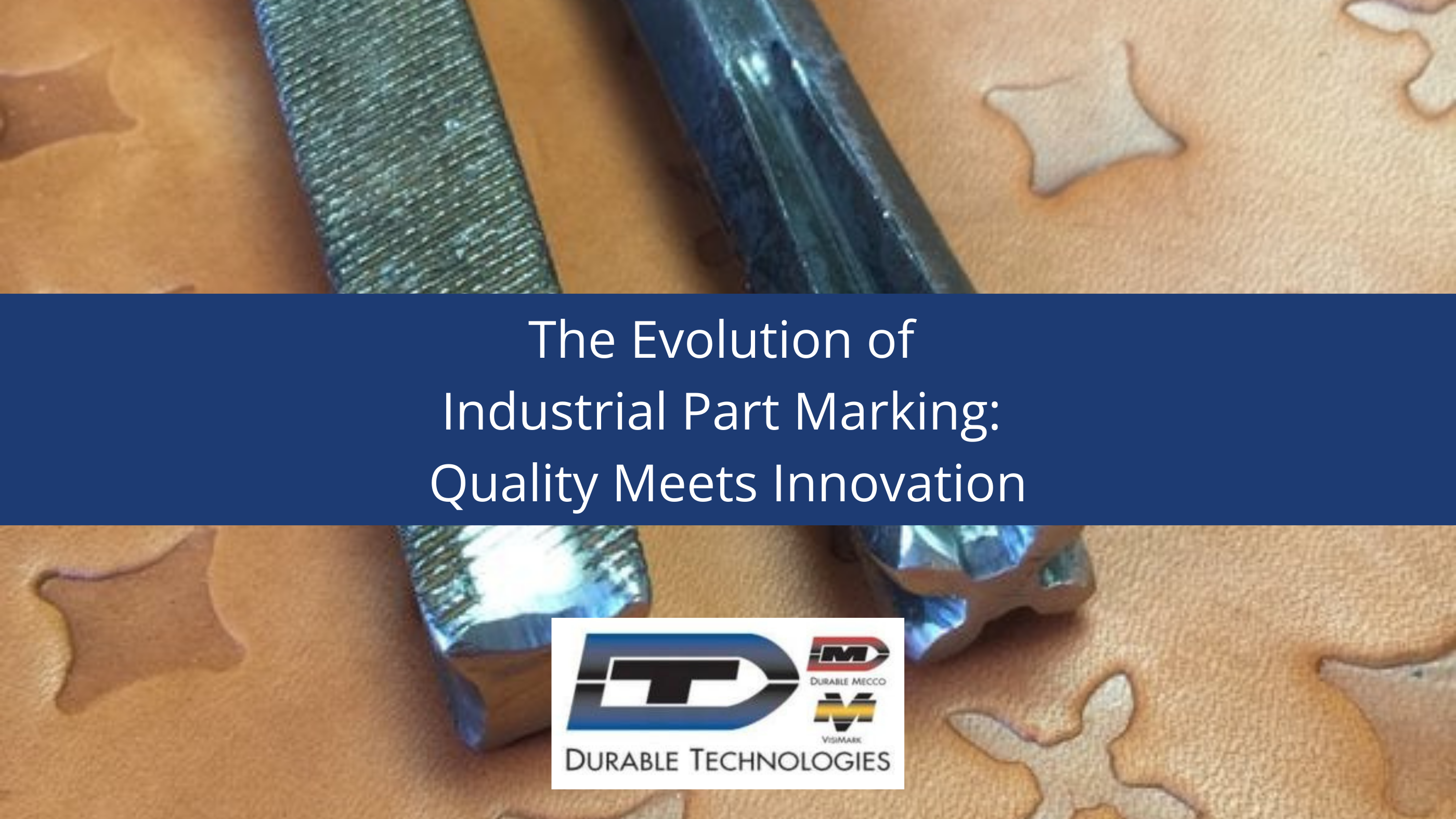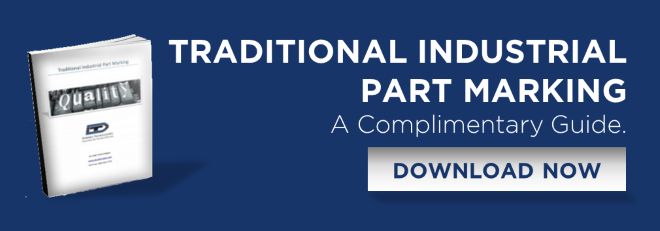4 min read
The Evolution of Industrial Part Marking: Quality Meets Innovation
Matt Martin
Wed, Jun 04, 2025 @ 08:06 AM

In today's manufacturing landscape, part marking has evolved far beyond simple identification. As industries push boundaries with advanced materials and complex supply chains, the quality of industrial marking has become crucial for traceability, compliance, and brand integrity.
Modern part marking sits at the intersection of tradition and innovation. While time-tested methods like hand stamping continue to deliver reliability, newer technologies are transforming how manufacturers approach permanent marking across diverse materials.
The Enduring Value of Traditional Marking Methods
Despite rapid technological advancement, traditional manual marking methods remain essential across numerous industries. Hand stamps are extremely versatile, offering many options in style and size. Typically made with standard characters (A-Z, 0-9, and punctuation), custom hand stamps can be made-to-order with designs ranging from simple text to complex logos.
Direct part marking has a long, rich history and is used in nearly every industry on almost every surface type. For many applications, industrial marking needs to be accomplished quickly, cleanly, and permanently with minimal complexity—requirements that have led to the development of high-quality traditional marking methods specifically designed for industrial use.
The staying power of traditional methods comes down to several key advantages:
Reliability Without Power Requirements: Hand stamping is the simplest direct part marking method available, requiring only a stamp and hammer to create a permanent mark on a wide range of materials. This makes it particularly valuable for small volume operations, field work, and environments where electrical power may be unreliable.
Economic Accessibility: Hand stamps are relatively inexpensive and easy to use, making them popular for artists and artisans looking to customize their work. This accessibility extends to small manufacturers who may not have the capital investment for automated systems but still need quality marking capabilities.
Material Versatility: Traditional methods like hand stamping work effectively across diverse materials, including various types of metal, wood, and plastics. For small businesses working with multiple materials, having a single marking solution that works across their entire product line offers significant operational advantages.
Craftsman Control: When striking the hand stamp with a hammer, only striking one time and pulling the hammer away immediately prevents double or triple impressions. The speed and accuracy of the hammer blow when striking the stamp are critical. This level of tactile feedback gives experienced craftsmen precise control over marking depth and appearance that some automated systems cannot match.
Balancing Tradition and Technology
The most forward-thinking manufacturers are not abandoning traditional methods but rather integrating them strategically with newer technologies:
Hybrid Marking Systems: Some manufacturing operations maintain both traditional and advanced marking capabilities, deploying each where they offer the most advantage. Hand stamps might be used for simple identification marks, while laser systems are capable of handling more complex variable data requirements.
Enhanced Traditional Tools: Safety and productivity improvements have led to innovations like specialized stamp holders that protect operators while improving marking consistency. Designs like the Safety First stamp grip provide improved hand protection with a 4" diameter shield that protects the operator's hand during stamping.
Traditional Marking for Specialized Materials: Some advanced materials still respond better to conventional impact marking than to newer technologies. Certain alloys, for instance, may be more effectively marked with properly applied impact techniques than with laser energy that can affect surface properties.
Preserving Craftsmanship: Small businesses like Artemas Quibble in Brooklyn demonstrate the continued relevance of traditional methods. The company designs jewelry and accessories and collaborates with their partners to create custom hand stamps from salvaged materials like old metal files and deconstructed tools, turning unusual materials into fully functional hand stamps.
Industry-Specific Traditional Applications
Several industries continue to rely heavily on traditional marking methods:
Blacksmithing and Metalworking: Steel stamps and dies remain one of the most durable and cost-effective solutions for making permanent marks on metals. They continue to be used across various industries, including metal fabrication, automotive, aerospace, firearms, oil and gas, blacksmiths, bladesmiths, jewelers, and hobbyists.
Leatherworking: Hot stamping and branding are particularly valuable for marking leather goods where other marking methods may not be suitable. Traditional hot stamping's temperature control and pressure application create distinctive, permanent marks that become part of the product's character.
Wood Products: When branding wood products, important factors in creating uniform quality marks include the design of the engraved die, die temperature, thermal capacity of the branding tool, pressure during branding, and dwell time for each brand. This hands-on approach allows for fine-tuning based on wood type and desired marking appearance.
Small-Batch Production: Direct part marking customization is an excellent way for many small businesses, craftsmen, and artisans to differentiate their products and create unique pieces. While this customization often involves custom tooling, the right partnerships can make the process affordable even in small runs.
Quality Considerations in Manual Marking
The quality of traditional marking comes down to proper technique and understanding of materials:
When hand stamping, having a solid, stable bench positioned over a support or leg helps eliminate bounce or flexing of the bench surface. Using a large, flat piece of soft steel as a base to lay parts on provides stability during marking. Choosing the proper marking hammer weight is also critical—for marking a single 1/4" tall character into mild steel, approximately 2 tons of pressure is needed, typically requiring a 3/4 to 1-1/4 lb. hammer.
For hot branding applications, a clean, crisp engraved die with the proper draft, face, and depth for the specific material being branded is essential for creating a clear branded impression. Die temperature varies significantly depending on the material.
The Future: Integration Rather Than Replacement
The future of industrial marking is not about replacing traditional methods but rather about strategic integration of both old and new approaches. Forward-thinking manufacturers are developing systems where:
-
- Traditional marking methods handle applications where they excel
- Automated systems take on high-volume, variable data requirements
- Quality verification systems ensure consistent outcomes regardless of the marking method
- Documentation captures marking processes for both traditional and advanced techniques
As manufacturing continues to evolve, the wisdom embedded in traditional marking methods provides a foundation upon which modern technologies can build. The skilled application of a well-crafted stamp still delivers a quality mark that modern technologies sometimes struggle to match, particularly on challenging materials or in specialized applications.
The companies that will lead in part marking quality are those that respect the craftsmanship of traditional methods while embracing the possibilities of emerging technologies, creating marking systems that combine the best of both worlds.




